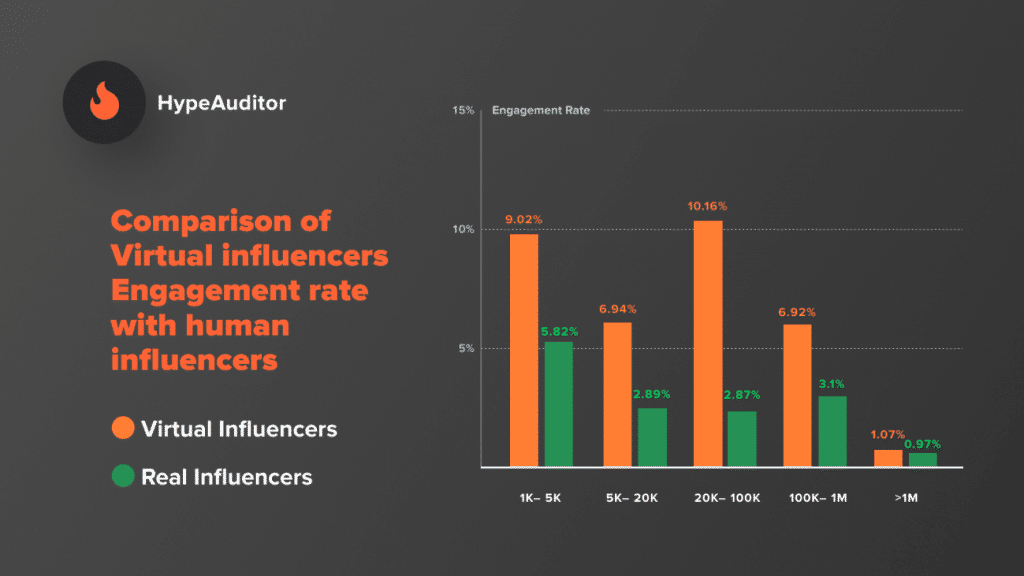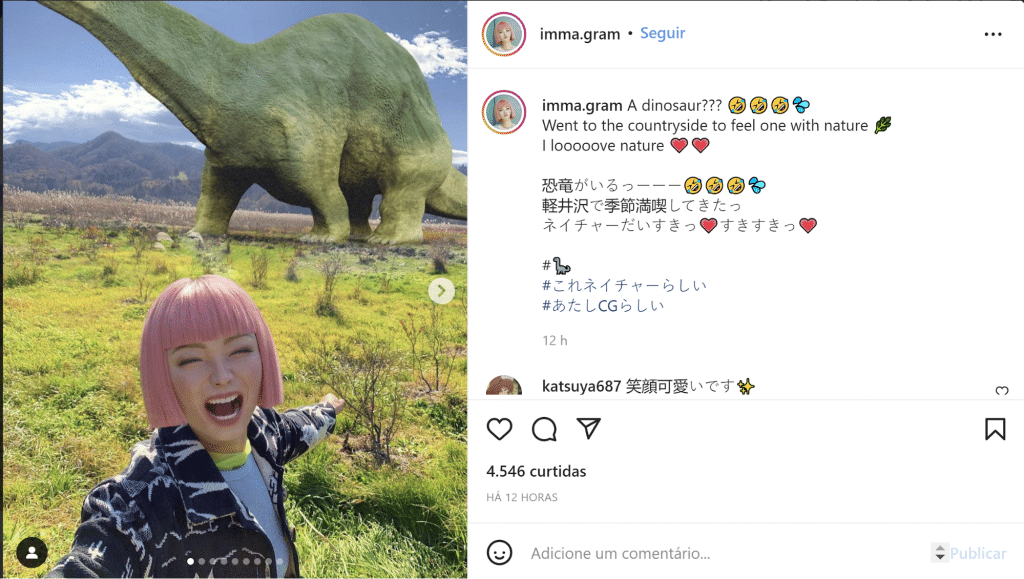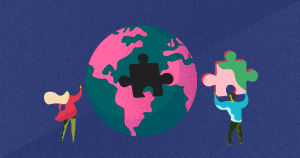It seems that we are already living in the future.
When we talk about Artificial Intelligence (AI), Machine Learning, robots, and the metaverse, most of us still treat it as Science Fiction. But, in many ways, some of that is already part of our lives.
One phenomenon that proves that is the rise of Artificially Intelligent influencers.
They do not exist in real life, but they can win fans and build a loyal audience. They are made of algorithms, not flesh and blood, but they can influence the behaviors of real people.
What explains this? What makes people admire and follow someone who “does not exist”? How do these virtual characters acquire this power of influence?
While some still do not fully understand why digital influencers are so successful, the emergence of AI influencers might be even more challenging to comprehend.
But those who work with Digital Marketing need to keep an eye on this phenomenon, as it can transform the relationship with consumers in the coming years.
That’s why we’ve written this article with everything you need to know about AI influencers, who they are, and how you can integrate them into your Digital Marketing strategies. Check it out.
- What are AI Influencers?
- How are they Different from other Influencers?
- What Explains the Phenomenon of AI influencers?
- Why should Brands use AI Influencers in Digital Marketing?
- Examples of AI influencers
- Wrap Up
Download this post by entering your email below
What are AI Influencers?
AI influencers are virtual personalities managed by brands or media agencies and created with computer graphics technology and Machine Learning algorithms.
They are a virtual, computerized version of digital influencers — that is, real people who have gained fame and influence through social media, blogs, and other online channels.
Similar to actual users, AI influencers have millions of followers, a loyal and engaged audience, and the power to influence the behavior and lifestyle of their fans.
This is why they are also in the sights of brands who want to associate themselves with powerful and influential personalities — even if they don’t exist in the real world.
Although they are often synonyms, AI influencers can be thought of as an evolution of virtual influencers created with computer-generated imagery (CGI). Therefore, they are also called CGI influencers.
On the other hand, AI influencers have a layer of technology based on Artificial Intelligence and Machine Learning, adding to the complexity of their characters.
In this way, these personalities can not only appear in photos or move around in videos for social media, but they can also interact virtually with users as if they were real people.
This happens automatically, without any human intervention, other than during the development of the systems.
As these robots interact with users in text form or virtual realities, they learn about human language and behavior, increasingly becoming similar to real humans.
How are they Different from other Influencers?
One of the main characteristics of AI influencers is amazing, but at the same time, worrying: their perfection.
Real influencers are “people like us”. Although they propagate an ideal of beauty and lifestyle on social networks, which is much criticized nowadays, they are vulnerable.
They can make mistakes, argue, be criticized — simply because they are human. On the other hand:
AI influencers tend to be perfect
These influencers’ appearance and personality traits are meticulously designed to meet specific objectives.
And if they represent a brand, they cannot be flawed or make any mistakes.
This perfection, however, opens a discussion about the search for unattainable standards, especially by children, teenagers, and other vulnerable audiences.
This is already discussed in the universe of digital influencers, but it becomes even more complex with AI influencers.
In fact, one may question whether real influencers, who post only “instagrammable” images, usually edited, are actually real or just an unrealistic version of themselves?
Despite the discussions, it is important to realize that perfection is only one side of AI influencers’ freedom to create.
You can create their personality from scratch
You have the power to build an influencer with authentic characteristics and stories, instead of looking for someone that looks like the persona you want to meet.
You can also design tailored strategies and actions for brands without relying on the limitations of a real influencer.
You can even create influencers that don’t look like humans — mascots, for example, can be influencers. For brands, this is valuable and opens up a wide range of possibilities for actions.
In any case, the freedom of creation has limits. After all, the personality of the virtual influencer needs to be coherent, so it is not possible to think of extravagant ideas that deviate from their usual behavior.
Otherwise, the audience that follows them might find it strange and stop believing in that character.
The virtual influencer does not exist alone
They have a team behind them — usually a media company that manages their “career”.
So, every action goes through negotiation with the company, which also defines the guidelines and possibilities.
What Explains the Phenomenon of AI influencers?
AI influencers may still seem like a very distant idea — even a bit delusional, right?
You may be wondering what kind of madness society is living in when a character that does not even exist can be so influential in people’s lives.
But the truth is that these characters do exist in people’s lives. Human beings are capable of relating, feeling empathy and even treating robots like people.
We interact with the world through our bodies and behaviors; therefore, we can interact socially with things that are not real.
In the case of AI influencers, we are talking about robots that are very similar to humans. In some cases, they may not even look like humans, but they are able to express themselves like us.
They may not exist physically, but they certainly have a meaning in the lives of their followers.
It is also necessary to understand the power of artificially intelligent influencers in the context of the digital age we live in.
This idea becomes more comprehensible if we think of the metaverse, an immersive digital future in which we will live a good part of our lives in virtual realities.
The rise of NFTs also happens in this context, where digital life becomes more important than physical life.
Works of art and collectible items that only exist virtually are sold for thousands or millions of dollars — in currencies that are also virtual.
So, if life is going to become (or is already becoming) essentially digital, it is easier to understand why people naturally relate to virtual characters.
It is also understandable that brands look closely at these influencers, as they have the power to connect and communicate with people in this new universe.
In the metaverse, through avatars, these interactions will probably not be as strange as they seem now.
Why should Brands use AI Influencers in Digital Marketing?
Marketing must keep up with the changes in society, always keeping an eye on the current trends.
So, if the next few years point to the metaverse, brands should start understanding the power of AI influencers and how they can be included in strategies.
Just like human digital influencers, AI influencers also have the trust and admiration of their audiences.
They influence lifestyles and behaviors and have their values associated with brands’ images. This is why influencer marketing has gained so much relevance in recent years.
But if you already understand the power of influencers, we will now show you why it is worth including AI influencers in your Digital Marketing plan.
1. Increased engagement
When partnering with influencers, one of the biggest goals for brands is to increase engagement on social media.
And when we talk about virtual influencers, they can be more engaging than human influencers.
In the graph below, you can compare the percentage of engagement of virtual influencers (in orange) and real influencers (in green).
This difference can be explained by the curiosity that this type of profile still sparks on social networks. People want to talk to robots, as it is still relatively uncommon.
But this can also be explained by the relevance of the interactions — as they are machines, they know exactly what to answer to get more engagement.

2. Narrative freedom
When brands negotiate with AI influencers, they are not dealing with a real personality.
In fact, they are negotiating with a media team, which can create a fully customized narrative for the brand.
Everything can be the way the partner brand wants it to be — as long as the actions are consistent with the influencer’s personality.
Therefore, brands have more control over the narrative and creative freedom to develop the ideal character for their strategies.
3. Power of storytelling
If the characters and stories can be created from scratch, with creative freedom, it is possible to tell even more exciting stories to the audience.
They are tailor-made to bring together the most engaging elements of storytelling to achieve the brand’s objectives. It is possible to create a fictional universe with creativity and fantasy.
The influencer’s origins, the activities they perform in their daily lives, the challenges they face, the good and bad feelings — all this is part of the creation with a virtual influencer.
But it can be used to tell a compelling and persuasive story to the audience.
4. Association with technology and innovation
Creating an AI influencer or partnering with one is a way to show that your brand is tuned with the trends.
This kind of strategy associates technology and innovation with your brand image since we are talking about Artificial Intelligence, Machine Learning, and the Metaverse.
If it is interesting to associate these values with your brand, it is worth making partnerships with AI influencers.
Take, for example, this Samsung Galaxy ad, which is a partnership with Miquela, one of the world’s best known virtual influencers:

5. Connecting with new generations
Millennials and Generation Z are still unfamiliar with some of the new features of the Internet and technology. But the Alpha generation, born as of 2010, is already growing up in the digital age.
These new generations will interact with technologies much more naturally and emotionally.
They will be the protagonists of an era that is much more interactive and immersive with technologies, marked by an effective relationship between humans and machines.
Therefore, the Alpha generation — and the ones that will follow — will interact with virtual characters much more closely.
This way, brands can take advantage of partnerships with these personalities to approach these new consumers.
Examples of AI influencers
Want to understand in practice how artificially intelligent influencers act? Let’s look at some examples that are already active on social networks!
But it is important to know that these profiles may have AI technology involved in their development, but they do not interact with users automatically yet.
For now, they are just CGI influencers, with a team behind them that makes the posts and interactions with users.
However, it is likely that, in the future, these personalities will appear in the metaverse and interact with people naturally — as if we were in an episode of Black Mirror!
Miquela
Miquela is already one of the most established virtual influencers.
She was created in 2016 as a virtual character with her own narrative. At first, however, no one was told that this was someone who did not exist in reality.
However, the perfection of her look and hair without a strand out of place began to intrigue followers. Then Miquela revealed: “I’m a robot”.
Since then, Miquela has partnered with brands — Calvin Klein and Prada, for example — and taken a stand on important issues, such as the rise of the Black Lives Matter movement.

Noonoouri
Noonoouri is an influencer and virtual model who advocates for free and sustainable fashion. On social media, she positions herself as a vegan activist.
Her look is a little different from other influencers. The character does not look exactly like a person because she has exaggeratedly large eyes. It is clearly a graphic creation, not a human being.
This visual option is interesting to avoid the Uncanny Valley. This concept is a scientific hypothesis, according to which people would feel repulsed when a human replica behaves very similar — but not identical — to human beings.
According to this idea, when it is clear that a character is not a human being, the response tends to be more positive and empathetic.

Knox Frost
Did you notice how the main examples of AI influencers are women?
That is why we have also selected a male profile: Knox Frost. In fact, this is the male influencer with the most followers on Instagram.
Knox is just like any other guy his age: he wants to fit into the world and have his own style. But he never stops contributing and giving back to his community: during the coronavirus pandemic, the World Health Organization partnered with the influencer to raise awareness about Covid-19 care and mental health among young people.

Imma
Imma is the first virtual influencer in a country with a highly technological reputation, Japan.
She first appeared in July 2018 and since then has gained space among the country’s influencers: her current follower count on Instagram is way beyond 300,000 followers.
The Japanese virtual influencer claims to be interested in “Japanese culture, film, and art” and has worked with brands such as Adidas, Burberry, TikTok, and IKEA Japan.
Given her success, she was selected as “New 100 Talent to Watch” by Japan Economics Entertainment.

Wrap Up
Now you know some names of virtual influencers increasingly known and admired.
Just like digital influencers, they can move marketing, strengthen branding, and enhance relationships with consumers.
All this is supported by advanced technology, which will probably transform the relationship between humans and robots in the coming years.
From now on, we can no longer say that digital influencers do not exist in real life. They just don’t exist physically, but they already exist in Marketing strategies and the lives of their followers.
After learning about AI influencers, take a moment to understand more about the role of AI in Marketing!








